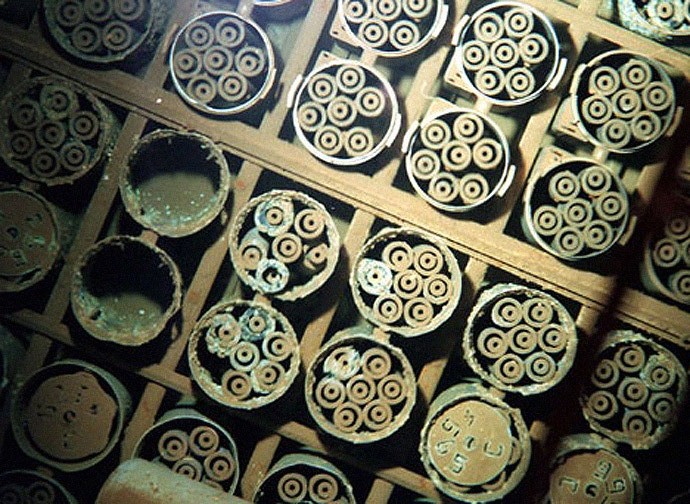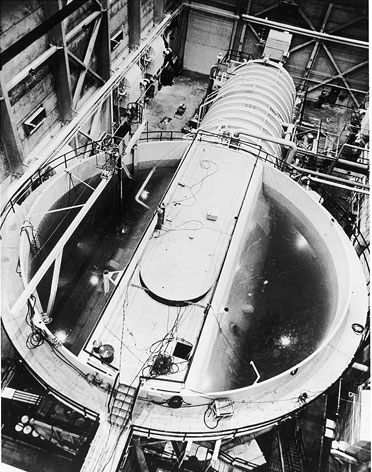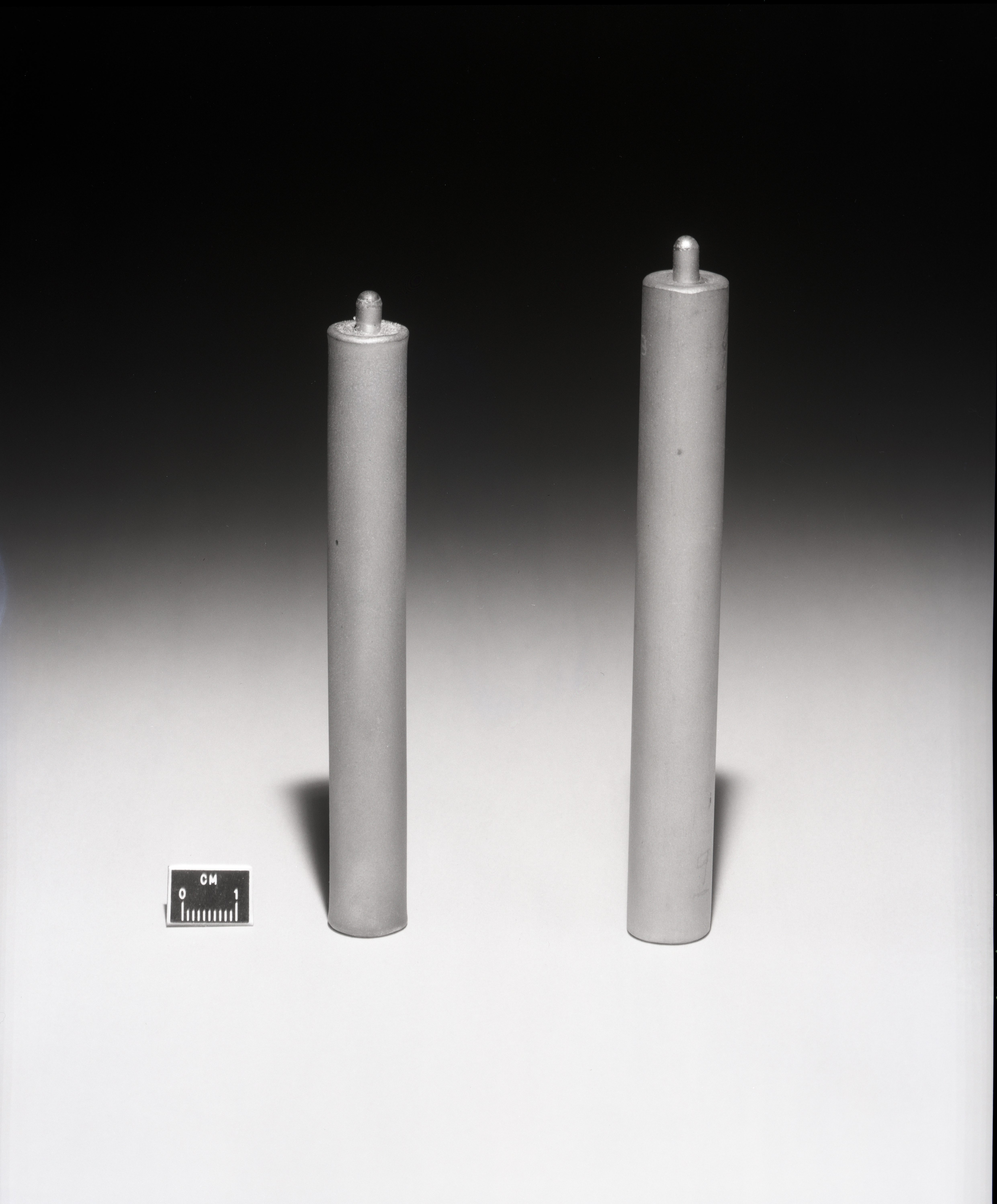|
Synroc
Synroc, a portmanteau of "synthetic rock", is a means of safely storing radioactive waste. It was pioneered in 1978 by a team led by Professor Ted Ringwood at the Australian National University, with further research undertaken in collaboration with ANSTO at research laboratories in Lucas Heights. Manufacture Synroc is composed of three titanate minerals – hollandite, zirconolite and perovskite – plus rutile and a small amount of metal alloy. These are combined into a slurry to which is added a portion of high-level liquid nuclear waste. The mixture is dried and calcined at to produce a powder. The powder is then compressed in a process known as Hot Isostatic Pressing (HIP), where it is compressed within a bellows-like stainless steel container at temperatures of . The result is a cylinder of hard, dense, black synthetic rock. Comparisons If stored in a liquid form, nuclear waste can enter the environment and the waterways, and cause widespread damage. As a solid, these ri ... [...More Info...] [...Related Items...] OR: [Wikipedia] [Google] [Baidu] |
Radioactive Waste
Radioactive waste is a type of hazardous waste that contains radioactive material. Radioactive waste is a result of many activities, including nuclear medicine, nuclear research, nuclear power generation, rare-earth mining, and nuclear weapons reprocessing. The storage and disposal of radioactive waste is regulated by government agencies in order to protect human health and the environment. Radioactive waste is broadly classified into low-level waste (LLW), such as paper, rags, tools, clothing, which contain small amounts of mostly short-lived radioactivity, intermediate-level waste (ILW), which contains higher amounts of radioactivity and requires some shielding, and high-level waste (HLW), which is highly radioactive and hot due to decay heat, so requires cooling and shielding. In nuclear reprocessing plants about 96% of spent nuclear fuel is recycled back into uranium-based and mixed-oxide (MOX) fuels. The residual 4% is minor actinides and fission products the latter of ... [...More Info...] [...Related Items...] OR: [Wikipedia] [Google] [Baidu] |
High-level Radioactive Waste Management
High-level radioactive waste management concerns how radioactive materials created during production of nuclear power and nuclear weapons are dealt with. Radioactive waste contains a mixture of short-lived and long-lived nuclides, as well as non-radioactive nuclides. There was reportedly some of high-level nuclear waste stored in the United States in 2002. The most troublesome transuranic elements in spent fuel are neptunium-237 (half-life two million years) and plutonium-239 (half-life 24,000 years). Consequently, high-level radioactive waste requires sophisticated treatment and management to successfully isolate it from the biosphere. This usually necessitates treatment, followed by a long-term management strategy involving permanent storage, disposal or transformation of the waste into a non-toxic form. Radioactive decay follows the half-life rule, which means that the rate of decay is inversely proportional to the duration of decay. In other words, the radiation from a lon ... [...More Info...] [...Related Items...] OR: [Wikipedia] [Google] [Baidu] |
Portmanteau
A portmanteau word, or portmanteau (, ) is a blend of wordsGarner's Modern American Usage , p. 644. in which parts of multiple words are combined into a new word, as in ''smog'', coined by blending ''smoke'' and ''fog'', or ''motel'', from ''motor'' and ''hotel''. In , a portmanteau is a single morph that is analyzed as representing two (or more) underlying morphemes. When portmanteaus shorten established [...More Info...] [...Related Items...] OR: [Wikipedia] [Google] [Baidu] |
England
England is a country that is part of the United Kingdom. It shares land borders with Wales to its west and Scotland to its north. The Irish Sea lies northwest and the Celtic Sea to the southwest. It is separated from continental Europe by the North Sea to the east and the English Channel to the south. The country covers five-eighths of the island of Great Britain, which lies in the North Atlantic, and includes over 100 smaller islands, such as the Isles of Scilly and the Isle of Wight. The area now called England was first inhabited by modern humans during the Upper Paleolithic period, but takes its name from the Angles, a Germanic tribe deriving its name from the Anglia peninsula, who settled during the 5th and 6th centuries. England became a unified state in the 10th century and has had a significant cultural and legal impact on the wider world since the Age of Discovery, which began during the 15th century. The English language, the Anglican Church, and Engli ... [...More Info...] [...Related Items...] OR: [Wikipedia] [Google] [Baidu] |
Sellafield
Sellafield is a large multi-function nuclear site close to Seascale on the coast of Cumbria, England. As of August 2022, primary activities are nuclear waste processing and storage and nuclear decommissioning. Former activities included nuclear power generation from 1956 to 2003, and nuclear fuel reprocessing from 1952 to 2022. Reprocessing ceased on 17 July 2022, when the Magnox Reprocessing Plant completed its last batch of fuel after 58 years of operation. The licensed site covers an area of , and comprises more than 200 nuclear facilities and more than 1,000 buildings. It is Europe's largest nuclear site and has the most diverse range of nuclear facilities in the world situated on a single site. The site's workforce size varies, and before the COVID-19 pandemic was approximately 10,000 people. The UK's National Nuclear Laboratory has its Central Laboratory and headquarters on the site. Originally built as a Royal Ordnance Factory in 1942, the site briefly passed int ... [...More Info...] [...Related Items...] OR: [Wikipedia] [Google] [Baidu] |
British Nuclear Fuels Limited
British Nuclear Fuels Limited (BNFL) was a nuclear energy and fuels company owned by the UK Government. It was a manufacturer of nuclear fuel (notably MOX), ran reactors, generated and sold electricity, reprocessed and managed spent fuel (mainly at Sellafield), and decommissioned nuclear plants and other similar facilities. It was created in February 1971 from the de-merger of the production division of the UK Atomic Energy Authority (UKAEA). Until 2003, its headquarters were at Risley, near Warrington, England. BNFL's headquarters were then moved to Daresbury Park industrial estate, also near Warrington. On 1 April 2005, BNFL formed a new holding company and started a rigorous restructuring process which would transfer or sell most of its entire domain, divisions. In 2005, it transferred all of its nuclear sites to the Nuclear Decommissioning Authority. It then sold its Westinghouse Electric Company subsidiary in February 2006. Later, BNFL sold the separate companies that ... [...More Info...] [...Related Items...] OR: [Wikipedia] [Google] [Baidu] |
Plutonium
Plutonium is a radioactive chemical element with the symbol Pu and atomic number 94. It is an actinide metal of silvery-gray appearance that tarnishes when exposed to air, and forms a dull coating when oxidized. The element normally exhibits six allotropes and four oxidation states. It reacts with carbon, halogens, nitrogen, silicon, and hydrogen. When exposed to moist air, it forms oxides and hydrides that can expand the sample up to 70% in volume, which in turn flake off as a powder that is pyrophoric. It is radioactive and can accumulate in bones, which makes the handling of plutonium dangerous. Plutonium was first synthetically produced and isolated in late 1940 and early 1941, by a deuteron bombardment of uranium-238 in the cyclotron at the University of California, Berkeley. First, neptunium-238 ( half-life 2.1 days) was synthesized, which subsequently beta-decayed to form the new element with atomic number 94 and atomic weight 238 (half-life 88 years). Since ... [...More Info...] [...Related Items...] OR: [Wikipedia] [Google] [Baidu] |
Idaho National Laboratory
Idaho National Laboratory (INL) is one of the national laboratories of the United States Department of Energy and is managed by the Battelle Energy Alliance. While the laboratory does other research, historically it has been involved with nuclear research. Much of current knowledge about how nuclear reactors behave and misbehave was discovered at what is now Idaho National Laboratory. John Grossenbacher, former INL director, said, "The history of nuclear energy for peaceful application has principally been written in Idaho". Various organizations have built more than 50 reactors at what is commonly called "the Site", including the ones that gave the world its first usable amount of electricity from nuclear power and the power plant for the world's first nuclear submarine. Although many are now decommissioned, these facilities are the largest concentration of reactors in the world. It is on a complex in the high desert of eastern Idaho, between Arco to the west and Idaho ... [...More Info...] [...Related Items...] OR: [Wikipedia] [Google] [Baidu] |
Hot Isostatic Pressing
Hot isostatic pressing (HIP) is a manufacturing process, used to reduce the porosity of metals and increase the density of many ceramic materials. This improves the material's mechanical properties and workability. The process can be used to produce waste form classes. Calcined radioactive waste (waste with additives) is packed into a thin walled metal canister. The adsorbed gases are removed with high heat and the remaining material compressed to full density using argon gas during the heat cycle. This process can shrink steel canisters to minimize space in disposal containers and during transport. It was invented in the 1950s at the Battelle Memorial Institute and has been used to prepare nuclear fuel for submarines since the 1960s. It is used to prepare inactive ceramics as well, and the Idaho National Laboratory has validated it for the consolidation of radioactive ceramic waste forms. ANSTO (Australian Nuclear Science and Technology Organisation) is using HIP as part of ... [...More Info...] [...Related Items...] OR: [Wikipedia] [Google] [Baidu] |
United States Department Of Energy
The United States Department of Energy (DOE) is an executive department of the U.S. federal government that oversees U.S. national energy policy and manages the research and development of nuclear power and nuclear weapons in the United States. The DOE oversees the U.S. nuclear weapons program, nuclear reactor production for the United States Navy, energy-related research, and domestic energy production and energy conservation. The DOE was created in 1977 in the aftermath of the 1973 oil crisis. It sponsors more physical science research than any other U.S. federal agency, the majority of which is conducted through its system of National Laboratories. The DOE also directs research in genomics, with the Human Genome Project originating from a DOE initiative. The department is headed by the Secretary of Energy, who reports directly to the president of the United States and is a member of the Cabinet. The current Secretary of Energy is Jennifer Granholm, who has served ... [...More Info...] [...Related Items...] OR: [Wikipedia] [Google] [Baidu] |
Leaching (metallurgy)
Leaching is a process widely used in extractive metallurgy where ore is treated with chemicals to convert the valuable metals within into soluble salts while the impurity remains insoluble. These can then be washed out and processed to give the pure metal; the materials left over are commonly known as tailings. Compared to pyrometallurgy, leaching is easier to perform, requires less energy and is potentially less harmful as no gaseous pollution occurs. Drawbacks of leaching include its lower efficiency and the often significant quantities of waste effluent and tailings produced, which are usually either highly acidic or alkali as well as toxic (e.g. bauxite tailings). There are four types of leaching: # Cyanide leaching (e.g. gold ore) # Ammonia leaching (e.g. crushed ore) # Alkali leaching (e.g. bauxite ore) # Acid leaching (e.g. sulfide ore) Chemistry Leaching is done in long pressure vessels which are cylindrical (horizontal or vertical) or of horizontal tube form ... [...More Info...] [...Related Items...] OR: [Wikipedia] [Google] [Baidu] |
Australian Broadcasting Corporation
The Australian Broadcasting Corporation (ABC) is the national broadcaster of Australia. It is principally funded by direct grants from the Australian Government and is administered by a government-appointed board. The ABC is a publicly-owned body that is politically independent and fully accountable, with its charter enshrined in legislation, the ''Australian Broadcasting Corporation Act 1983''. ABC Commercial, a profit-making division of the corporation, also helps to generate funding for content provision. The ABC was established as the Australian Broadcasting Commission on 1 July 1932 by an act of federal parliament. It effectively replaced the Australian Broadcasting Company, a private company established in 1924 to provide programming for A-class radio stations. The ABC was given statutory powers that reinforced its independence from the government and enhanced its news-gathering role. Modelled after the British Broadcasting Corporation (BBC), which is funded by a tel ... [...More Info...] [...Related Items...] OR: [Wikipedia] [Google] [Baidu] |




.jpg)



